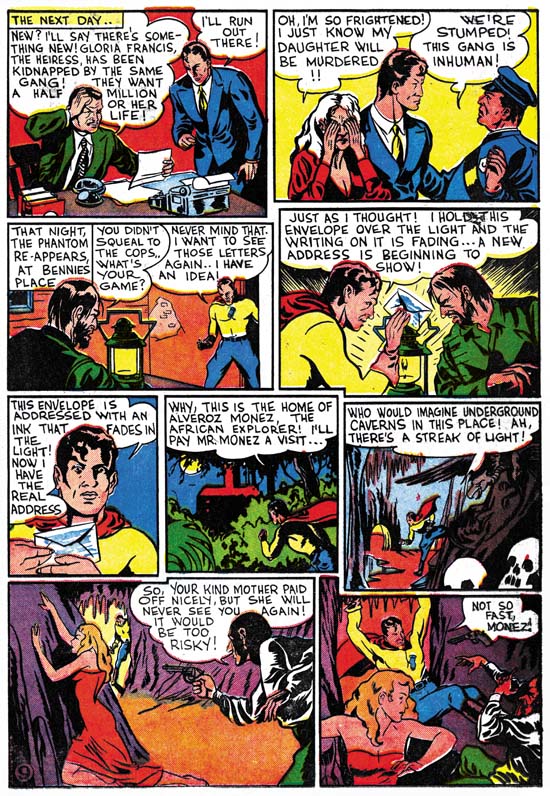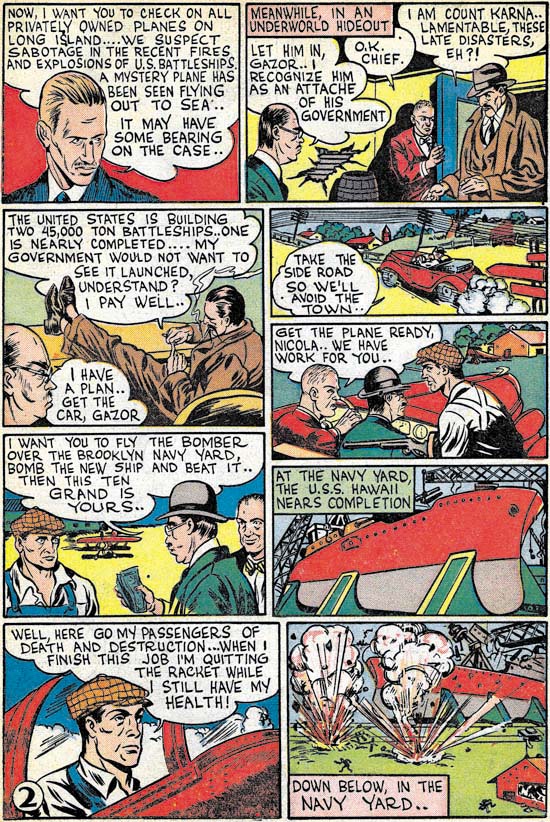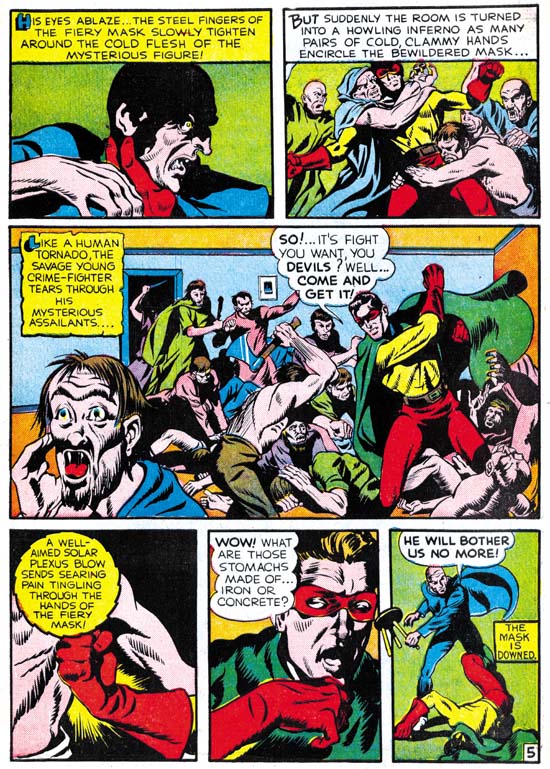The GCD lists Joe Simon as the artist for Solar Patrol in Silver Steak #3 (February 1940) and renamed as Planet Patrol in SS #4 (March 1940). I have not seen either so I cannot verify this attribution. Still the timing and Joe’s frequent signing of his work makes it likely to be correct.

Target Comics #1 (February 1940) “The Case of the Black Widow Spider” by Joe Simon (signed)
In February titles we also find Joe Simon starting a feature in Target Comics #1 (Novelty Press) called T-Men. He does a similar job to the one he did in the tree man story for Solar Patrol. One important difference is that although he still does not use the standard panel layout, his deviation from a strict grid are small and there is never any question about the proper reading sequence. The story is a little better then the Solar Patrol one, but it is without the improvements shown in his Fiery Mask story for Timely. This may be just Joe still trying to adjust to a new art media. However I suspect that the T-Man story may have actually been done at about the same time as Solar Patrol but the publication of it was delayed. This is the first part of a two part story. But the way the first part ends leads me to wonder whether if it was originally meant to be two parts. The ending seems abrupt and not like a planned cliffhanger. When the story continues in the next issue it is quickly wrapped up in a few panels. My suspicion is that the story was originally eight pages. Either this is not the length the publisher asked for, or a length change was required later. In either case Joe did a little fixing to make it a seven page story with a “to be continued”. But when Joe returned to the story for the next issue he knew he wanted to have a half page splash and he wanted to proceed with the new story line. So he cut panels from the former eight page and pasted on the new page. If I am correct this is the earliest example of Joe using cut and paste as an editorial method, a technique that he would use throughout the rest of his career.

Daring Mystery #2 (February 1940) “Phantom Bullet” by Joe Simon (signed)
The Fiery Mask did not reappear in the second issue of Daring Mystery. Instead Joe launched two new features. The first was Phantom Bullet. The hero has a gun that shots ice bullets. The idea being that after the ice bullet has done its work it melts, leaving the police without a clue. This was a hero? Although Joe still has a way to go, he has made progress in his comic artistry. Like last month’s Fiery Mask, this one has a pretty good story and the art work shows improvement. But Simon is still doing simplified drawing and his trademark angled eye/eyebrow remain. But his style seems consistent throughout the story. You might think that this was an indication that Joe did not do any swiping here, but you would be wrong. Take the kidnapped lady in panel 8 of page 9, rotate her until she is upside down, take a mirror image, and move her arms a bit and presto change-o she becomes the damsel in distress from the cover of Silver Streak #2. I said you would see her again. Guess what, Joe is still not finished with her.

Daring Mystery #2 (February 1940) “Trojak” by Joe Simon (signed Gregory Sykes)
Another new feature for Daring Mystery #2 was a Tarzan clone called Trojak. This one is signed by Gregory Sykes. But don’t bother searching GCD or any other database for Sykes because you will not find any other trace of him. The way the “by” is written on the title panel, the similar ‘S’, the same style of page numbering, and the art style in Phantom Bullet and Trojak leaves no doubt that were both done by Joe Simon. Joe had so far shown a desire to promote himself, why not on Trojak as well? In all likelihood Joe was worried that Goodman would not want two stories by the same artist in one comic. I looked through the GCD listings for Daring Mystery in search for any other possible pseudonyms. I did find a couple of names that sounded suspicious; Maurice Gutwirth and George Kapitan. But further searching showed that they both actually were legitimate artists with a long record of comic book work. So Gregory Sykes seems a rare example of Simon using a pseudonym.

Daring Mystery #2 (February 1940) “Trojak” by Joe Simon (signed Gregory Sykes)
Although stylistically similar to Phantom Bullet, the art in the Trojak story looks better. A lot of this has to do with all the action that was possible with Trojak and a jungle full of animals. The style is pretty uniform throughout the story except some of the natives look more developed. Sure enough, doesn’t the chief in panel 3 of the splash page look like the tree man from Solar Patrol? I wonder what the original source looked like?
The GCD does list Joe Simon as the artists for Trojak in Daring Mystery #3 (April 1940), #4 (May) and #5 (June). The date for #3 seems reasonable, those for #4 and #5 less so, but still possible. Daring Mystery #6 (September) includes art by Jack Kirby and so postdates this chapter.

Target Comics #2 (March 1940) “Sabotage” by Joe Simon (signed)
As mentioned previously the T-Men in this issue starts by wrapping up the story line from the previous issue. Although handled much too quickly, the way the villain gets his just desserts is really quite funny. Hopefully someday this story will be reprinted. The art for the wrap up is a good match for what was done in the Target #1. However the rest of the story is done in a style that closely matches the stories in Daring Mystery #2 from the previous month. Joe uses larger page number in a circular field, exactly the same as in Daring Mystery #2. Further evidence that the publication of the work Joe did for Target was delayed a month compared to other titles.
The GCD lists Joe Simon as doing the T-Men feature in Target #3 (April 1940) but that one is signed Ben Thompson and was done in a different style. Ben Thompson has a history of doing comics at this time so I do not think it is a pseudonym. The GCD also list Simon as the artist for T-Men in Target #4 (May 1940). However I have not seen that issue.

Human Torch #2 (1) (Fall 1940) “The Strange Case of the Bloodless Corpses” by Joe Simon
The first issue of the Human Torch was number 2 because Timely took over the numbering from Red Raven. With the high prices of key golden age comics, like the Human Torch #2, we are fortunate that Marvel has reprinted it recently. Red Raven #1 is cover dated September 1940, so the Human Torch #2 clearly comes after Joe and Jack met. But the Fiery Mask story in this issue was done by Joe Simon alone in a style similar to that he used before meeting Jack. This story is included here because I suspect that it might have been done earlier then its publication date would indicate. For those of you that have Greg Theakston’s “The Complete Jack Kirby, 1917-1940” compare the panel by Hal Foster of a man hollering with the one in the left corner of panel 3. Once more it appears that Joe is swiping from the same source material more then once.
In these first two chapters we saw Joe Simon adopt his own style. Yes there are variations due to Joe developing his skill, and there are also differences due to Joe’s swiping. But careful examination for Joe’s style can provide attributions even when the work is not signed. I could say that armed with this knowledge we are now prepared to identify all of Simon’s early work. I could say that, but it would not be true. In our next chapter we will see Joe adopt an entirely different style.


Hi Harry,
The Fiery Mask story from Human Torch #2 is interesting. The word baloons are lettered by Joe Simon, but the narration is lettered by Howard Ferguson. Ferguson’s earliest work on Joe Simon, as per Greg, is Blue Bolt #5 Oct. 1940.
The Fiery Mask story in Daring Mystery #6 Sep, 1940, with shared art by Joe and Jack, is lettered by Joe Simon.
Does this appearance by Howard Ferguson show that the story in HT#2 was drawn after the DM story, or could this have been reworked with Ferguson adding the narration?
Stan,
Thanks for the lettering information. I admit it is an area I have not studied. It could mean that the HT #2 story was done later then I suggested. Or it could mean that an older story was reworked somewhat.
I don’t know if Ferguson lettering shows that HT #2 was later then DM #2. But I do feel that the art style suggests that. But unfortunately as I said in the first chapter I do not have access to all of Joe’s early work. For now my feeling is that HT #2 is closer to DM #2 then it is to Joe’s contribution to DM #6. But I am getting ahead of myself.